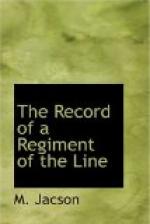The operation that followed was not, however, so successful. Colonel Knox reported that his mounted troops had gone out eight miles up the Newcastle road past Limit Hill, and had not met or seen a single Boer. He suggested that the Cavalry Brigade should go out and capture and burn the Boer stores at Elandslaagte Station. They proceeded to carry out the suggestion, starting at 7 a.m., but they fell in with a large force of Boers under Pepworth Hill who had been in their laagers when the reconnaissance was made and had thus escaped detection. They came under heavy musketry fire as well as shell fire, and retired back to Ladysmith with a loss of three killed and fifteen wounded.
On December 10th an attack on Devon Post was expected, and precautions taken accordingly. The attack, however, did not come off.
On the night of December 10th the Rifle Brigade made a sortie and blew up a Boer big gun on Surprise Hill. This attack was admirably planned and carried out, but the losses sustained by the Rifle Brigade were heavy, being fourteen killed and fifty wounded out of the five companies employed. The Boers attacked them as they were retiring; there was a good deal of indiscriminate firing, and the bayonet was freely used. The Boers lost considerably, partly in the general mix-up, from their own fire, and partly owing to the close-quarter combat with the Rifle Brigade.
The Regiment, with other troops, was ordered out with all baggage on the night of the 12th, the rendezvous being the iron bridge on the Vanreenen’s Pass road. On arrival there the order was received to go home. This was supposed to be a rehearsal for a sortie. On December 13th General Buller’s guns were heard for the first time due south from Ladysmith, and at 8 p.m. the Regiment and transport were inspected by Colonel Knox to see if everything was complete and in readiness to move out, and on the 14th the Regiment was placed with other troops in a flying column formed under the personal command of Sir George White.
It was expected by all that General Buller would relieve the Ladysmith garrison on December 15th.
The following day, December 15th, a very heavy cannonade commenced at 6 a.m. in the direction of Colenso; and at 7 a.m. a heliograph message was sent into Ladysmith which told the garrison that “the Boers are suffering terribly from our thirty guns and 23,000 men.” The cannonade ceased at about 1 p.m.
This day the meat ration was reduced to 9 oz. per man, but 1-1/4 lb. of bread per man was still being issued.
December 16th being Dingaan’s Day, the garrison of Ladysmith was treated to heavy shell fire at daybreak.
On December 17th the Regiment and the Gordon Highlanders were told off as reserve battalions under the immediate orders of Sir George White.
It was officially given out that Sir R. Buller had been unable to make good his advance at Colenso, and that the garrison must be prepared to hold on for another two weeks. The orders publishing this news stated that the “Lieutenant-General regrets to have to announce that the Lieutenant-General Commanding-in-Chief in South Africa failed to make good his first attack on Colenso; reinforcements will therefore not arrive as early as expected.”




